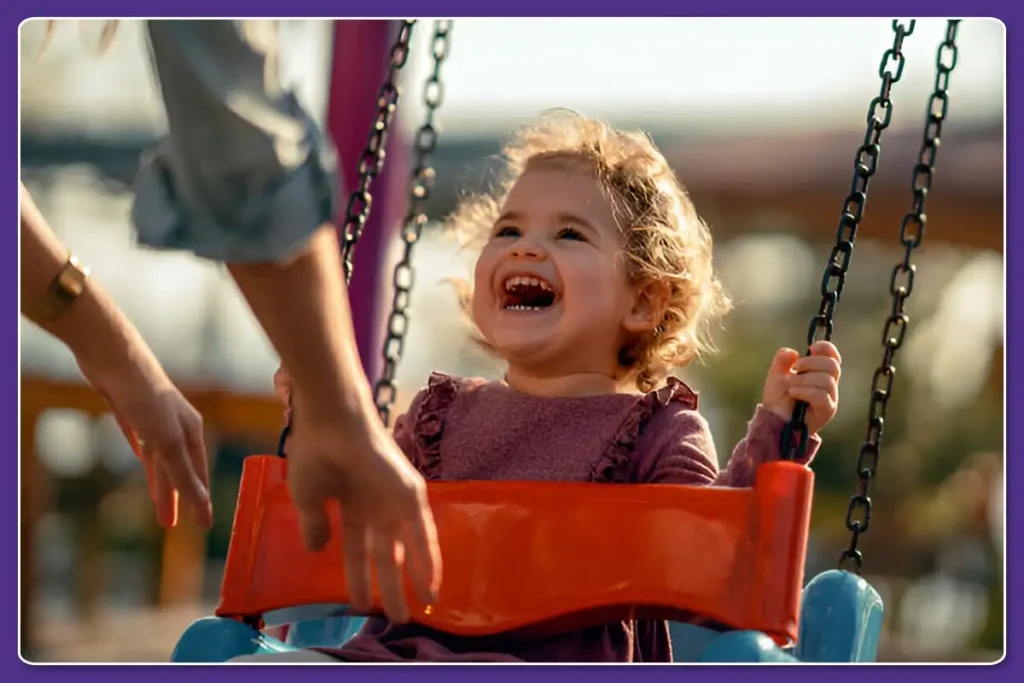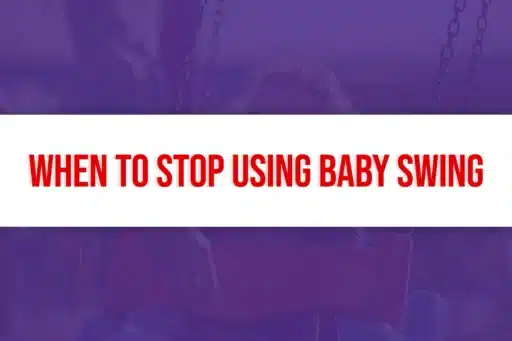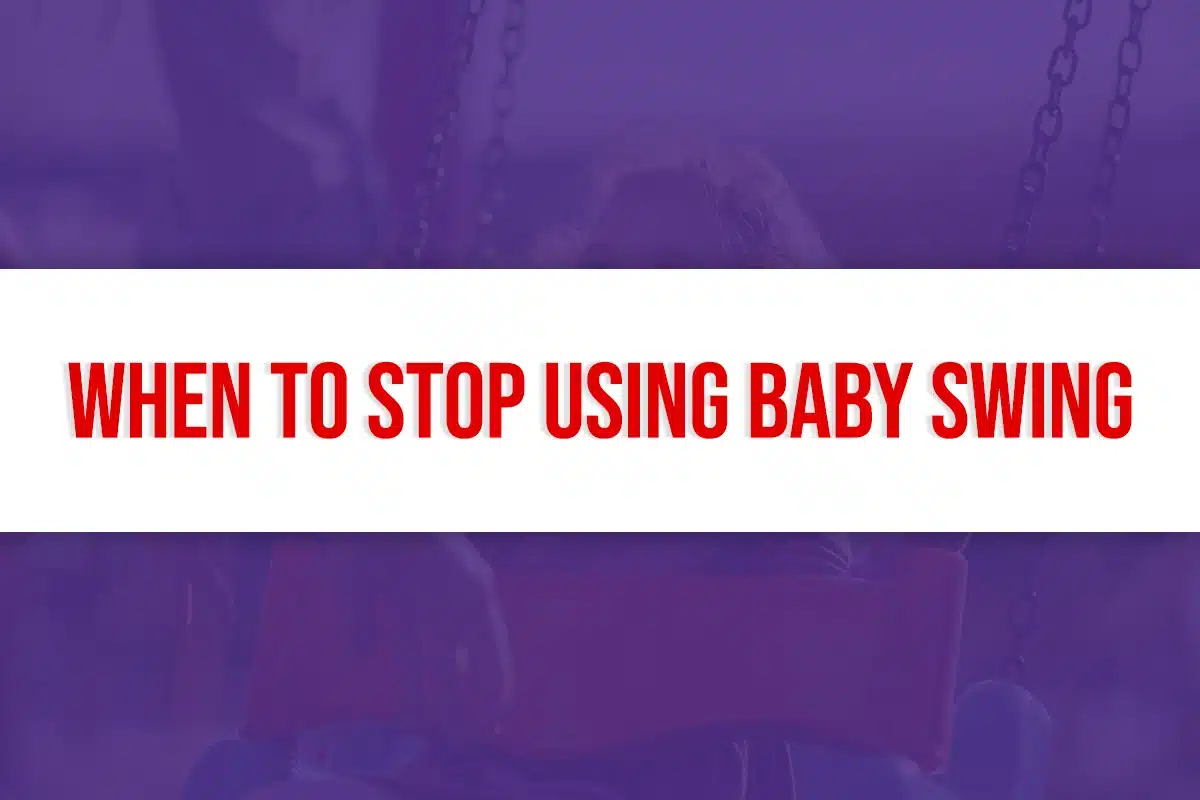Knowing when to stop using a baby swing is crucial for your child’s safety. This decision varies based on several factors.
Every parent wants their baby to be comfortable and safe. Baby swings provide comfort and help soothe a fussy baby. But as your baby grows, there comes a time to transition out of the swing. Understanding the best age to stop using a baby swing can help ensure your child’s development progresses smoothly.
In this blog post, we will explore the key signs and age milestones to guide you in making this important decision. Let’s dive into when it’s best to say goodbye to the baby swing and hello to new adventures.

Introduction To Baby Swings
Baby swings are a common item in many households with infants. These devices help soothe and entertain babies. They provide gentle rocking motions, which mimic the movements that babies experience in the womb. This can be very calming for them.
Purpose Of Baby Swings
The main purpose of baby swings is to offer comfort to infants. They serve as a safe place where babies can rest or nap. Baby swings also provide a fun and engaging environment. Many swings come with toys and music, which can keep babies entertained.
Benefits For Infants
Baby swings offer several benefits for infants:
- Soothing Motion: The gentle swinging motion helps calm fussy babies.
- Entertainment: Built-in toys and music keep babies engaged.
- Hands-Free Time for Parents: Parents can use the swing to keep their baby occupied while they attend to other tasks.
- Encourages Napping: Many babies fall asleep easily in a swing.
These benefits make baby swings a valuable tool for many parents. They provide a safe and enjoyable space for infants to relax.
Signs Your Child Is Ready
Knowing the right time to stop using a baby swing can be challenging for many parents. Recognizing the signs your child is ready to transition out of a baby swing is crucial for their safety and development. Below, we cover key physical and behavioral indicators that signal your child is ready to move on.
Physical Development Milestones
Physical development is a strong indicator that your child may be ready to stop using the baby swing. Here are some milestones to watch for:
- Sitting up unaided: When your child can sit up without support, it shows increased muscle strength and balance.
- Rolling over: If your baby is rolling over with ease, they may no longer need the swing’s support.
- Increased weight: Most baby swings have a weight limit. Check the manufacturer’s guidelines to ensure your child is still within the safe range.
Behavioral Indicators
Behavioral changes can also signal that your child is ready to stop using the baby swing. Look for these signs:
- Restlessness: If your child is fussy and restless in the swing, they may need more freedom to move.
- Interest in other activities: A growing interest in crawling or exploring the room means your child may be ready for new challenges.
- Decreased comfort: If your baby appears uncomfortable or cries more often in the swing, it might be time for a change.
Paying attention to these physical and behavioral signs will help you determine the best age to stop using a baby swing. Always prioritize your child’s safety and comfort during this transition.
Recommended Age Range
Parents often wonder about the best age to stop using a baby swing. It’s crucial to know when to transition your child for their safety and development.
Expert Opinions
Pediatricians suggest that a baby swing should be used with caution. Experts recommend stopping use once the baby starts sitting up independently. This usually occurs around 4 to 6 months.
Using the swing beyond this age could pose risks. Babies become more active and curious, which increases the chances of accidents. Always consult your pediatrician for personalized advice.
Average Age To Transition
On average, most parents transition their babies out of swings by 6 months. Here is a quick reference table for better understanding:
| Age (Months) | Development Milestone | Recommended Action |
|---|---|---|
| 0-3 | Newborn | Safe to use swing |
| 4-6 | Sitting up, Rolling Over | Start transitioning |
| 6+ | More Active and Curious | Stop using swing |
Keep an eye on your baby’s development. A good rule of thumb is to stop using the swing around 6 months. This ensures your child is safe and ready for new challenges.
Safety Concerns
When considering the best age to stop using a baby swing, safety concerns play a crucial role. Parents must ensure their child’s well-being and avoid potential risks associated with prolonged use. This section will address the primary safety concerns that arise from using a baby swing beyond the recommended age.
Risks Of Prolonged Use
Prolonged use of a baby swing can lead to developmental issues. Babies need floor time to develop motor skills. Using the swing too much limits this.
There is also a risk of flat head syndrome from extended time in the swing. The baby’s head rests in one position, which can cause this problem.
Older babies can become more active and try to climb out. This increases the risk of falling and injury.
Safe Transition Practices
Gradually reducing swing time helps in a smooth transition. Start by decreasing the time your baby spends in the swing each day.
Introduce other soothing methods, like rocking in your arms or using a bouncy seat. This helps the baby adjust without feeling sudden changes.
Ensure the baby’s sleep environment is safe. Use a firm mattress and avoid loose bedding. This is crucial as the baby transitions from the swing to the crib.
Always supervise the baby during the transition period. This ensures their safety and helps them feel secure.
| Age | Recommended Practices |
|---|---|
| 0-3 months | Use the swing for short periods. |
| 3-6 months | Start reducing swing time. |
| 6-9 months | Introduce other soothing methods. |
| 9+ months | Stop using the swing completely. |
Alternative Soothing Methods
As your baby grows, you may need to find new ways to soothe them. Baby swings are great, but there comes a time to move on. Thankfully, there are many alternative soothing methods that can work just as well. Here are some tried-and-true options:
Rocking Chairs
Rocking chairs are a classic choice for calming a fussy baby. The gentle back-and-forth motion mimics the movements they felt in the womb. This can be very comforting.
Choose a chair with a smooth, silent rock. You want to avoid loud creaks that might wake your baby. Upholstered rocking chairs provide both comfort and support.
If you don’t have a rocking chair, you can use a regular chair. Simply hold your baby close and sway gently. This can be just as effective.
Swaddle Techniques
Swaddling is another excellent method for soothing babies. It recreates the snug feeling of being in the womb. This makes babies feel safe and secure.
There are different swaddle techniques to try. Here is a simple method:
- Lay a blanket flat, folding one corner down.
- Place your baby face-up on the blanket, with their head above the folded corner.
- Wrap the left corner over their body and tuck it under their back.
- Bring the bottom corner up over their feet.
- Wrap the right corner around your baby and tuck it under their back.
Ensure the swaddle is snug but not too tight. Your baby should be able to move their hips and legs freely.
Swaddling can help reduce startle reflexes and promote better sleep. Just be sure to stop swaddling once your baby starts rolling over.
Creating A Smooth Transition
Transitioning your baby from a swing to a crib can be a challenging phase. It is essential to make the process smooth and stress-free for both you and your baby. This section will guide you through strategies to ensure a seamless transition.
Gradual Reduction Strategy
A gradual reduction strategy helps babies adjust without abrupt changes. Start by reducing the time your baby spends in the swing. Initially, let your baby spend 30 minutes less each day in the swing. Gradually increase the reduction time over a week.
- Week 1: Reduce swing time by 30 minutes each day.
- Week 2: Reduce swing time by 60 minutes each day.
- Week 3: Reduce swing time by 90 minutes each day.
By the end of three weeks, your baby should be spending minimal time in the swing. This gradual reduction helps babies acclimate slowly to the new routine.
Incorporating New Routines
Introducing new routines can also ease the transition. Establishing a consistent bedtime routine helps your baby feel secure.
- Bath Time: A warm bath before bedtime can relax your baby.
- Story Time: Reading a short, calming story can make your baby sleepy.
- Lullabies: Singing or playing soft lullabies can soothe your baby.
- Cuddling: Spend a few minutes cuddling your baby before putting them in the crib.
These routines signal that it’s time to sleep, helping your baby adjust to the new sleeping environment.
Remember, consistency is key. Stick to these routines every night to help your baby adapt quickly and comfortably.
Parental Tips And Tricks
Transitioning your child from a baby swing can be challenging. Here are some tips to make the process smoother and encourage independence.
Encouraging Independence
Helping your child become more independent is crucial. Start by reducing the time they spend in the swing. Gradually increase their time on the floor with toys. This helps them explore and develop motor skills.
Create a safe play area where they can move freely. Use soft mats or carpets. Place their favorite toys within reach. This encourages them to crawl and play on their own.
Involve them in simple activities. For example, let them help with picking up toys. This builds confidence and independence.
Positive Reinforcement
Use positive reinforcement to make the transition easier. Praise your child for spending time outside the swing. Use encouraging words like “Good job!” or “You did great!”.
Offer small rewards for their efforts. This can be a favorite snack or extra playtime. Consistent positive reinforcement helps them feel proud and motivated.
Avoid using the swing as a solution for every fussy moment. Instead, try comforting your child in other ways. Hold them, sing, or read a story. This shows them that they can be comforted without the swing.
| Tip | Description |
|---|---|
| Reduce Swing Time | Gradually decrease the time spent in the swing. |
| Safe Play Area | Set up a safe space with toys and mats. |
| Positive Praise | Use encouraging words and praise their efforts. |
| Small Rewards | Offer rewards like snacks or extra playtime. |
| Alternative Comfort | Comfort them with holding, singing, or reading. |
Common Challenges
Transitioning away from using a baby swing can be challenging. Parents often face resistance from their little ones. There can also be disruptions in sleep patterns. Understanding these common challenges can help make the process smoother.
Dealing With Resistance
Children get attached to their swings. They enjoy the soothing motion. When the swing is taken away, they might resist. They may cry or throw tantrums. Stay calm and patient during this time. Gradually reduce the time your child spends in the swing. Introduce other comforting routines like reading or cuddling. This can help ease the transition.
Managing Sleep Disruptions
Many babies sleep well in their swings. Removing the swing might disturb their sleep. This is a common issue. Create a new, calming bedtime routine. Keep the room dark and quiet. Use a gentle lullaby or white noise. Consistency is key. Stick to the new routine every night. Over time, your baby will adjust and sleep better.
When To Seek Professional Advice
When it comes to deciding the best age to stop using a baby swing, parents often face uncertainty. While many rely on general guidelines, seeking professional advice can provide valuable insights tailored to your child’s needs. Consulting with experts ensures that your child’s safety and development are prioritized.
Consulting Pediatricians
Pediatricians play a crucial role in your child’s early development. They can offer personalized advice based on your child’s growth and milestones. A pediatrician can assess if your baby is ready to transition from the swing. They consider factors like weight, height, and motor skills. Regular check-ups with a pediatrician help monitor your baby’s progress. This ensures they are developing healthily and safely.
Behavioral Specialists
Behavioral specialists can provide insights into your child’s habits and behaviors. They can help identify if the baby swing affects your child’s sleep patterns. A specialist can guide you on creating a sleep schedule without the swing. They offer strategies to ease the transition from swing to crib. Consulting a behavioral specialist can help reduce anxiety for both parents and baby. It ensures a smoother and more comfortable transition.
Frequently Asked Questions
Babies should stop using swings around 6 months or when they can sit up unassisted. Always follow manufacturer guidelines.
Yes, baby swings are safe for newborns when used correctly. Ensure the swing has proper support and follows safety standards.
No, babies should not sleep in swings overnight. Always transfer them to a crib for safe sleep.
Alternatives to baby swings include bouncers, rockers, and play mats. These provide similar soothing benefits and developmental support.
Conclusion
Choosing the right time to stop using a baby swing is important. Pay attention to your child’s growth and development. Safety should always come first. Most parents find the right age between six to nine months. Always consult with your pediatrician if unsure.
Your child’s comfort and safety are the top priorities. Enjoy these precious moments with your little one. Embrace each milestone with love and care. Every child is unique. Make the best choice for yours.







